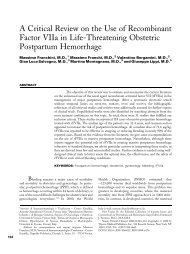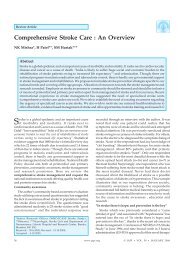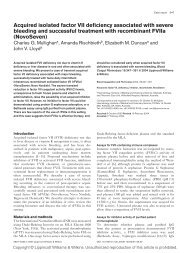Pathophysiology and management of dengue hemorrhagic fever
Pathophysiology and management of dengue hemorrhagic fever
Pathophysiology and management of dengue hemorrhagic fever
Create successful ePaper yourself
Turn your PDF publications into a flip-book with our unique Google optimized e-Paper software.
4<br />
CHUANSUMRIT & TANGNARARATCHAKIT<br />
enveloped (E) protein <strong>and</strong> seven non-structural (NS)<br />
proteins, NS1, NS2a, NS2b, NS3, NS4a, NS4b <strong>and</strong> NS5.<br />
The NS proteins are assumed to be involved in the<br />
replication <strong>of</strong> viral RNA. The proteins are synthesized<br />
as a large <strong>and</strong> single-polyprotein precursor <strong>of</strong> approximately<br />
3400 amino acids. They are transmitted among<br />
humans by Aedes mosquitoes such as Aedes aegypti <strong>and</strong><br />
Aedes albopictus.<br />
There are four distinct serotypes,<br />
namely <strong>dengue</strong> 1 to 4. Infection with any <strong>of</strong> the four<br />
serotypes causes similar clinical symptoms that may<br />
vary in severity, depending on a number <strong>of</strong> risk factors<br />
including virus virulence, viral load <strong>and</strong> host response.<br />
The genotypic differences <strong>of</strong> <strong>dengue</strong> virus appear to be<br />
associated with the difference in virulence. For instance,<br />
<strong>dengue</strong> serotype 2 <strong>of</strong> Southeast Asian genotype is associated<br />
with DHF while the original American genotype<br />
4–6<br />
is associated with <strong>dengue</strong> <strong>fever</strong>. Moreover, E protein<br />
gene <strong>and</strong> the 5′<br />
- <strong>and</strong> 3′<br />
-untranslated regions <strong>of</strong><br />
genomic RNA have determinants that may influence the<br />
efficiency <strong>of</strong> <strong>dengue</strong> virus replication in dendritic<br />
5,6 cells.<br />
CLINICAL PRESENTATION<br />
The three stages <strong>of</strong> clinical presentation are named<br />
7<br />
febrile, toxic <strong>and</strong> convalescent. The patients initially<br />
develop an abrupt onset <strong>of</strong> high <strong>fever</strong> (39–40°<br />
C) with<br />
malaise, headache, nausea, vomiting, myalgia <strong>and</strong>,<br />
sometimes, abdominal pain. During the acute febrile<br />
stage, which lasts 2–7 days, <strong>hemorrhagic</strong> manifestation<br />
is invariably present but usually mild (Table 1). Petechial<br />
hemorrhage on the skin is commonly found. Also,<br />
a positive tourniquet test is frequently observed. Bleeding<br />
at the nose, gastrointestinal tract <strong>and</strong> gums is relatively<br />
less common compared with petechiae, but may<br />
be severe. Recently, menorrhagia has been more prevalent<br />
because <strong>of</strong> the increasing number <strong>of</strong> affected<br />
adolescents. However, hematuria is extremely rare.<br />
Hepatomegaly is commonly found, <strong>and</strong> the liver is<br />
usually s<strong>of</strong>t <strong>and</strong> tender. Thrombocytopenia <strong>and</strong> rising<br />
hematocrit due to plasma leakage are usually detectable<br />
before the onset <strong>of</strong> the subsequent toxic stage. An<br />
abrupt fall to normal or subnormal levels <strong>of</strong> temperature,<br />
varying degrees <strong>of</strong> circulatory disturbance<br />
will develop, known as the toxic stage, lasts 24–48<br />
hours. Ultimately, the majority <strong>of</strong> patients have rapid<br />
uneventful recovery without sequelae in the convalescent<br />
stage.<br />
| MANAGEMENT OF DENGUE HEMORRHAGIC FEVER<br />
Table 1. Bleeding manifestations among 257 children with<br />
<strong>dengue</strong> <strong>hemorrhagic</strong> <strong>fever</strong><br />
Bleeding manifestations Number <strong>of</strong> patients %<br />
Petechiae 100 42.7<br />
Epistaxis 53 22.6<br />
Gastrointestinal bleeding 36 15.4<br />
Menorrhagia 25 10.7<br />
Gum bleeding 14 6.0<br />
Ecchymosis 4 1.7<br />
Hematuria 2 0.9<br />
DIAGNOSTIC CRITERIA<br />
7<br />
The clinical diagnosis <strong>of</strong> DHF is based on four major<br />
characteristic manifestations: (i) sustained high <strong>fever</strong><br />
lasting 2–7 days; (ii) <strong>hemorrhagic</strong> tendency such as a<br />
positive tourniquet test, petechiae or epistaxis; (iii)<br />
9<br />
thrombocytopenia (platelet count ≤ 100 × 10 /L); <strong>and</strong><br />
(iv) evidence <strong>of</strong> plasma leakage manifested by hemoconcentration<br />
(an increase in hematocrit ≥ 20% above<br />
average for age, sex <strong>and</strong> population), pleural effusion<br />
<strong>and</strong> ascites. Close observation, serial hematocrit <strong>and</strong><br />
daily platelet count monitoring are suggested in order<br />
to accomplish the clinical diagnostic criteria. Pleural<br />
effusion can be demonstrated by a chest X-ray in right<br />
lateral decubitus view at 12–24 hours after defervescence.<br />
These applications may be problematic in a busy<br />
pediatric practice in a <strong>dengue</strong>-endemic area. A study in<br />
Vietnam suggested to use <strong>fever</strong> <strong>and</strong> hemoconcentration<br />
together with either bleeding or thrombocytopenia as<br />
8<br />
clinical criteria <strong>of</strong> DHF. However, some patients with<br />
bleeding or anemia will not have a rising hematocrit.<br />
Therefore, the minimal criteria should include <strong>fever</strong> <strong>and</strong><br />
evidence <strong>of</strong> plasma leakage together with either bleeding<br />
or thrombocytopenia. Further evaluation in a large<br />
prospective series from other <strong>dengue</strong>-endemic regions<br />
is warranted.<br />
7<br />
The severity <strong>of</strong> DHF is categorized into four grades:<br />
grade I, without overt bleeding but positive for tourniquet<br />
test; grade II, with clinical bleeding diathesis such<br />
as petechiae, epistaxis <strong>and</strong> hematemesis; grade III,<br />
circulatory failure manifested by a rapid <strong>and</strong> weak<br />
pulse with narrowing pulse pressure ( ≤ 20 mmHg) or<br />
hypotension, with the presence <strong>of</strong> cold clammy skin <strong>and</strong><br />
restlessness; <strong>and</strong> grade IV, pr<strong>of</strong>ound shock in which<br />
pulse <strong>and</strong> blood pressure are not detectable. It is note-<br />
© 2006 The Authors<br />
Journal Compilation © 2006 LMS Group • Transfusion Alternatives in Transfusion Medicine 8 (Suppl. 1), 3–11





